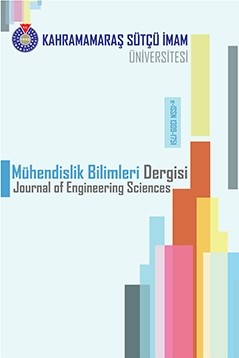KALDNES K1 ÜZERİNDE BİYOFİLM OLUŞUMUNUN İNCELENMESİ
AnHYBR, Biyofilm, Kaldnes K1, Tekstil atıksuyu
INVESTIGATION OF BIOFILM FORMATION ON KALDNES K1
AnMBBR, Biofilm, Kaldnes K1, Textile wastewater,
___
- Annachhatre A.P., Bhamidimarri S.M.R. (1992). Microbial attachment and growth in fixed film reactors: process startup considerations. Biotechnol. Adv., 10, 69–91.
- Ansari, M. I., Schiwon, K., Malik, A., & Grohmann, E. (2012). Biofilm formation by environmental bacteria. In Environmental protection strategies for sustainable development, 341-377.
- Apha, A. W. W. A. (1998). Standard methods for the examination of water and wastewater, 20. Washington, DC: American Public Health Association.
- Bassin, J. P., & Dezotti, M. (2018). Moving bed biofilm reactor (MBBR). In Advanced Biological Processes for Wastewater Treatment, 37-74.
- Boltz, J. P., Daigger, G. T., Austin, D., & Johnson, B. (2019). U.S. Patent Application, No. 16/165,617.
- Chen, S., Sun, D., Chung, J.S. (2008). Simultaneous removal of COD and ammonium from landfill leachate using an anaerobic-aerobic moving-bed biofilm reactor system, Waste Manage., 28 (2), 339–34.
- Chen, X., Kong, L., Wang, X., Tian, S., & Xiong, Y. (2015). Accelerated start-up of moving bed biofilm reactor by using a novel suspended carrier with porous surface. Bioprocess and biosystems engineering, 38(2), 273-285.
- Chu, L., Wang, J., Quan, F., Xing, X. H., Tang, L., & Zhang, C. (2014). Modification of polyurethane foam carriers and application in a moving bed biofilm reactor. Process Biochemistry, 49(11), 1979-1982.
- Copithorn, R. R. (2010). Introduction to biofilm reactors. In Biofilm Reactors. WEF Manual of Practice No. Alexandria, Virginia, USA: WEF Press/McGraw Hill, 35, 1–14.
- Copithorn, R. R. (2010). Introduction to biofilm reactors. In Biofilm Reactors. WEF Manual of Practice No. 35, 1–14. Alexandria, Virginia, USA: WEF Press/McGraw Hill.
- Flemming, H., Wingender, J., Szewzyk, U., Steinberg, P., and Rice, S. A. (2016). Biofilms: an emergent form of bacterial life. Nat. Rev. Microbiol., 14, 563–575.
- Kozak, M., Cirik, K., Başak, S. (2021). Treatment of textile wastewater using combined anaerobic moving bed biofilm reactor and powdered activated carbon-aerobic membrane reactor. Journal of Environmental Chemical Engineering, 9(4), 105596.
- Li, C., Felz, S., Wagner, M., Lackner, S., and Horn, H. (2016). Investigating biofilm structure developing on carriers from lab-scale moving bed biofilm reactors based on light microscopy and optical coherence tomography. Bioresour. Technol., 200, 128–136.
- Mahendran, B., Lishman, L., and Liss, S. N. (2012). Structural, physicochemical and microbial properties of flocs and biofilms in integrated fixed-film activated sludge (IFFAS) systems. Water Res., 46, 5085–5101.
- Morgan-Sagastume, F. (2018). Biofilm development, activity and the modification of carrier material surface properties in moving-bed biofilm reactors (MBBRs) for wastewater treatment. Critical reviews in environmental science and technology, 48(5), 439-470.
- Morper, M. R. (1994). Upgrading of activated sludge systems for nitrogen removal by application of the Linpor CN process. Water Science & Technology.
- Ødegaard, H. (2006). Innovations in wastewater treatment: The moving bed biofilm process. Water Sci. Technol., 53, 17–33.
- Ødegaard, H., Rusten, B., Siljudalen, J. (1999). The development of the moving bed biofilm process—from idea to commercial product. Eur. Water Manage, 2 (3), 36–43.
- Ødegaard, H., Rusten, B., Westrum, T. (1994). A new moving bed biofilm reactor—applications and results. Water Sci. Technol., 29(10–11), 157–165.
- Başlangıç: 1998
- Yayıncı: Kahramanmaraş Sütçü İmam Üniversitesi
Fevzi DUMANOĞLU, Bekir Cihad BAL
Serdar GÖÇER, Melike KOZAK, İrem AYRANPINAR, Ahmet DUYAR, Emre Oğuz KÖROĞLU, Kevser CIRIK
TERMOGRAVİMETRIK ANALİZ İLE FARKLI KÖMÜRLERİN YANMA PROSESİNİN İNCELENMESİ
Jale NAKTİYOK, Abdulkadir ÖZER
ELECTROCONDUCTIVE POLYAMIDE FIBERS WITH GREEN SYNTHESIZED SILVER NANOPARTICLES
Şeyma KANARA, Neslihan OKYAY, Fatih IŞIK, Suat CETİNER
SADEYAĞIN FARKLI BİTKİSEL YAĞLARLA KİMYASAL İNTERESTERİFİKASYONU
Ayşe Burcu AKTAŞ, Büşra Nur OKÇU, Deniz YAMAN, Bilge Başak BAYRAM
CEVİZ KABUĞUNUN DOĞAL BİYOSORBENT OLARAK ÇİNKO GİDERİMİNDE KULLANILMASININ ARAŞTIRILMASI
Sevda Esma DARAMA, Başak MESCİ OKTAY, Semra ÇORUH
Erşan Ömer YÜZER, Altuğ BOZKURT
İŞLEVSEL DERECELENDİRİLMİŞ DAİRESEL BİR KANATÇIĞIN TERMOELASTİK DAVRANIŞININ SAYISAL İNCELENMESİ
Ali YILDIRIM, Mehmet EKER, Durmuş YARIMPABUÇ, Volkan ARIKAN, Kerimcan ÇELEBİ
